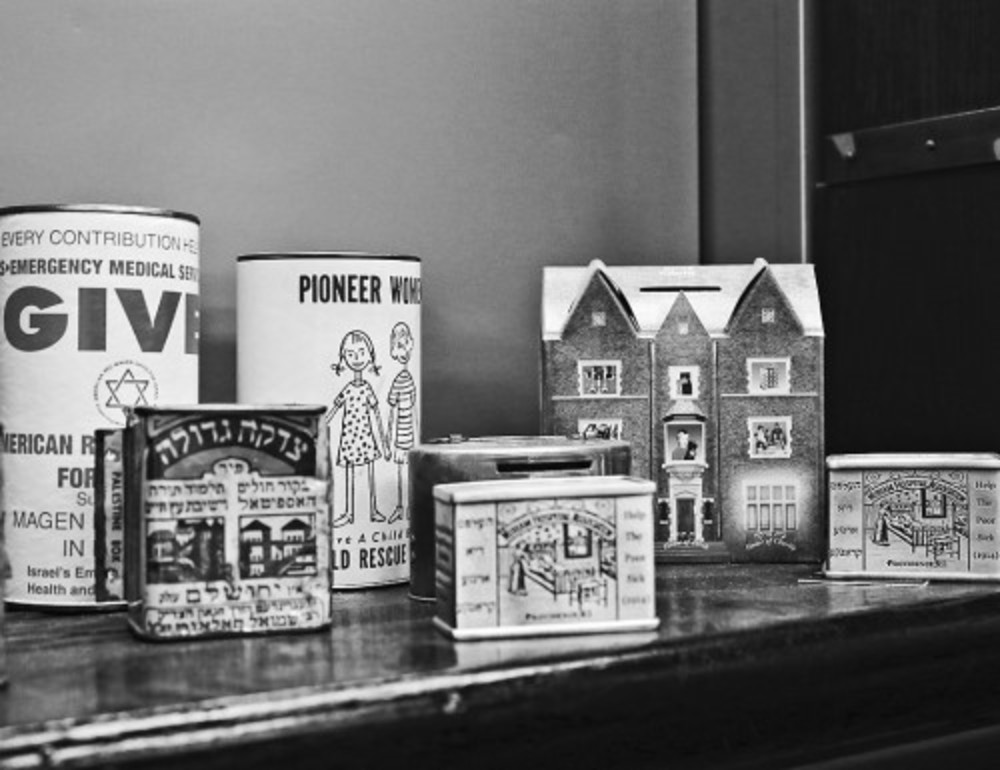A memory of kitchens past, a look to the future
 Part of a collection of pushkes from the R.I. Jewish Historical Association.
Part of a collection of pushkes from the R.I. Jewish Historical Association.
Back in the day, in the days of my childhood and youth, almost every Jewish kitchen had a pushke, or, as some pronounced it, pishke. Your pronunciation depended on the dialect of Yiddish spoken in the area of Europe in which your family originally lived.
A pushke is a receptacle with a slot on top into which money put aside for tzedakah is inserted. It can be a simple box or canister or an elaborate work of art. Fancy, embellished boxes were seldom found in kitchens, but they still served the same purpose – to collect tzedakah. They were decorative but not merely decorations or collectables. It should also be noted that pushkes weren’t limited to homes but were, and still are, found in public spaces, as well as wherever people may be moved to donate.
The pushkes found in the kitchens of my youthful years, the years prior to the end of World War II, came in many sizes and shapes: tall, squat, round, rectangular. Colors ranged from white to garish reds and mustardy gold, and each carried the name of the organization providing the pushke. Many of the boxes were metal alloy, others were cardboard with a metal top and bottom. The metal boxes had a small trap door with a lock to be opened by a key in the possession of a “collector,” someone paid by an agency, or a volunteer. After the container was emptied, the donor received a receipt for the contents. A key was not always necessary; a sharp object easily picked the flimsy lock.
Most of the organizations whose names were emblazoned on the containers were women’s organizations. The Zionist groups – Pioneer Women, Hadassah and Mizrachi – all collected money for schools and homes for refugee children arriving in Palestine, many clandestinely, before Israel existed. Whether called Child Rescue or Youth Aliyah, the money collected supported services for children in need. Sisterhoods and social welfare agencies also depended for part of their support on the pushkes found in the kitchens of members or supporters.
The most ubiquitous, however, was the “Blue Box,” the metal canister of Karen Kayemet, of the Jewish National Fund, which collected money to purchase land for kibbutzim, for building roads and infrastructure in Israel. Its face pictured a map of Palestine in white. It was a symbol of a dream and a hope, before there was an Israel. The original Blue Boxes underwent a number of changes in design, but the color endured.
On Erev Shabbat, before lighting the candles, the women of the house would drop a few coins into the pushkes. In times of celebration, or stress, a few more coins would be added to the tzedakah boxes.
Having multiple pushkes in the kitchen is now pretty much a part of the past. One or two is more likely the norm. As the Great Depression yielded to more prosperous times, as new technology lightened their workload, women had more time to devote to volunteering, going to meetings and pursuing careers. Since banks, after World War II, had begun touting personal checking accounts, it became easier to bring a check to a gathering or answer an appeal though the mail. Still, the tradition of dropping a few coins into a pushke (decorated or simple) before candle lighting on Erev Shabbat, and in times of celebration or stress, remains. It is a memory of the past, a look to the future.
The Rhode Island Jewish Historical Association has a small number of older or unusual pushkes: in Hebrew from Karen Kayemet, the Temple Emanuel Building Fund, United Charities of Jerusalem, the rebbe’s house shape from Chabad.
We welcome any and all additional pushkes, new or old, simple or decorated. They are a very important part of who we are, of our history in Rhode Island.
GERALDINE S. FOSTER is a past president of the Rhode Island Jewish Historical Association. To comment on this or any Rhode Island Jewish Historical Association article, email info@rijha.org







